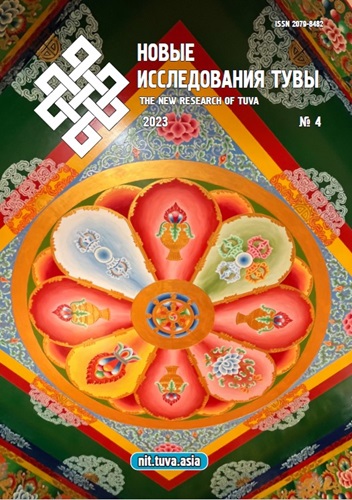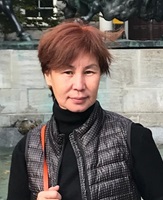Ritual ribbons and flags in the practical activities of contemporary Tuvans
DOI:
https://doi.org/10.25178/nit.2023.4.24Keywords:
Tuva; Tuvans; shamanism; Tuvan Buddhism; ritual ribbon; ritual scarf; Buddhist flag; consecration; ovaa; chalama; kadak; wind horse; ethnocultural neotraditionalismAbstract
The article analyzes the patterns of distribution of ritual ribbons and flags (chalama, kadak, tuk) in the sociocultural life of contemporary Tuva. The work is based on the materials collected by the authors in different parts of the Republic in 2012–2023. We consider the issues of terminology related ritual ribbons, flags and the origins of the tradition of their tying and use. It is emphasized that chalama have an ancient origin and are associated with the primordial shamanistic religion of the region. Kadaktar and tuktar are cultural borrowings, but the history of their spread in Tuvan rituals is already quite long, so they are considered as Tuvan traditional ones.
The topic of the distribution of ritual ribbons is considered in accordance with the typology of the objects on which they are tied and presented. These are places of shamanic worship and cults; consecrated animals; Buddhist facilities; non-religious objects; as well as people to whom kadaks are handed. The authors show the scale of the occurrence of ritual ribbons in the sociocultural life of the Tuvans, the explosive growth in demand for ribbons and flags. This has led to an increase in their sales and availability for the population. We provide some opinions of the surveyed Tuvans of different ages regarding the essence of the tying rituals and highlight the issues of educating the people, their ignorance in the basics of ritual practices and behavior in sacred places. All these lead to environmental problems.
In general, tying of ritual ribbons and flags is described as a manifestation of ethnocultural neotraditionalism.
References
Antonov, N. K. (1971) Materialy po istoricheskoi leksike iakutskogo iazyka [Materials on the historical vocabulary of the Yakut language]. Yakutsk, Yakut Publishing House. 175 p. (In Russ.).
Bakaeva, E. P. (2008) Odezhda v kul'ture kalmykov: traditsii i simvolika [Clothing in the Kalmyk culture: Traditions and symbols]. Elista, Gerel. 189 p. (In Russ.).
Beer, R. (2011) Entsiklopediia tibetskikh simvolov i ornamentov [Tibetan symbols and motifs] / transl. from English by L. Bubenkova. Moscow, Orientaliia. xx, 406 p. (In Russ.).
Burnakov, V. A. (2012) Tkan' v ritual'noi praktike khakasov [Textile in the ritual practice of the Khakas]. Vestnik Novosibirskogo gosudarstvennogo universiteta. Seriia: Istoriia, filologiia, vol. 11, no. 5, pp. 175–186. (In Russ.).
Weinstein, S. I. (1961) Tuvintsy-todzhintsy. Istoriko-etnograficheskie ocherki [Tozhu Tuvans: Historical and ethnographic essays]. Moscow, Publishing House of Oriental Literature. 218 p. (In Russ.).
Weinstein, S. I. (1974) Istoriia narodnogo iskusstva Tuvy [A history of folk art in Tuva]. Moscow, Nauka. 219 p. (In Russ.).
Weinstein, S. I. (2009) Zagadochnaia Tuva [The mysterious Tuva]. Moscow, Domashniaia gazeta. 416 p. (In Russ.).
Dagylga: tuvinskie obriady osviashcheniia v XXI veke [Dagylga: Tuvan rites of consecration in the 21st century] (2021) / ed. by Ch. K. Lamazhaa and N. D. Suvandii. Kyzyl, s. n. 188 p. (In Russ. and Tuv.).
Danilova, N. K. and Vasilyev, V. E. (2019) Religioznyi landshaft: «siel», «salama» i «delbirge» v ritual'nom prostranstve v svete izucheniia evoliutsii beskrovnykh zhertvoprinoshenii naroda sakha [Religious background: “siel”, “salama” and “delbirge” in ritualistic space in light of examination of evolution of bloodless sacrifices performed by Sakha people]. Obshchestvo: filosofiia, istoriia, kul'tura, no. 12 (68), pp. 30–35. (In Russ.). DOI: https://doi.org/10.24158/fik.2019.12.4
Dongak, S. Ch. (2018) Mal ydyktaar tyva ezulaldar = Tuvinskie obriady osviashcheniia skota [Tuvan rites of consecration of cattle]. Kyzyl, s. n. 52 p. (In Tuv. and Russ.).
Ekeeva, E. V. and Belekova, E. A. (2018) Kul'tovaia atributika v traditsionnom mirovozzrenii altaitsev [Cult paraphernalia in the traditional worldview of the Altayans]. Gorno-Altaysk, S. S. Surazakov Research Institute of Altaic Studies. 120 p. (In Russ.).
Zhambalova, S. G. (2023) Ritual'nye konoviazi serge u buriat v XXI veke [Ritual hitching posts serge among the Buryats in the 21st century]. Gumanitarnyi vektor, vol. 18, no. 1, pp. 123–132. (In Russ.). DOI: https://doi.org/10.21209/1996-7853-2023-18-1-123-132
Zhukovskaia, N. L. (1977) Lamaizm i rannie formy religii [Lamaism and early forms of religion]. Moscow, Nauka. 199 p. (In Russ.).
Katanov, N. F. (2011) Ocherki uriankhaiskoi zemli. Dnevnik puteshestviia, ispolnennogo v 1889 godu po porucheniiu Imperatorskoi Akademii nauk i Imperatorskogo Russkogo geograficheskogo obshchestva [Essays on the Uriankhai territory. The diary of a journey made in 1889 on behalf of the Imperial Academy of Sciences and the Imperial Russian Geographical Society]. Kyzyl, Tuvan Institute for Humanities Research under the Government of the Republic of Tuva. 384 p. (In Russ.).
Kenin-Lopsan, M. B. (2002) Mify tuvinskikh shamanov = Tyva khamnarnyң torulgalary [Myths of Tuvan shamans]. Kyzyl, Novosti Tuvy. 544 p. (In Russ. and Tuv.).
Kenin-Lopsan, M. B. (2006) Traditsionnaia kul'tura tuvintsev [Traditional culture of Tuvans] / transl. from Tuvan. Kyzyl, Tuvan Book Publishing House. 232 p. (In Russ.).
Kenin-Lopsan, M. B. (2009) Tuvinskie shamany [Tuvan shamans]. Moscow, Maska. 328 p. (In Russ.).
Kirilenko, E. I. (2020) Nit' na zapiast'e: tuvinskii opyt zdorov'ia (po materialam interv'iu so studentami tuvinskoi diaspory Tomska) [A piece of thread around the wrist: Tuvan experience of health as seen in interviews with students from the Tuvan diaspora in Tomsk]. The New Research of Tuva, no. 1, pp. 3–18. (In Russ.). DOI: https://doi.org/10.25178/nit.2020.1.1
Kisel, V. A. and Havrin, S. V. (2009) Gora Dogee kak arkheologicheskii i etnograficheskii pamiatnik Tuvy [The Dogee mountain as an archaeological and ethnographic monument of Tuva]. The New Research of Tuva, no. 4, pp. 101–108. (In Russ.).
Kurasov, S. V. (2013) Dekorativno-prikladnoe iskusstvo Tibeta: simvolika i struktura ritual'nykh ob"ektov [Tibetan decorative and applied arts: Symbolism and structure of ritual objects]. Vestnik Chuvashskogo gosudarstvennogo pedagogicheskogo universiteta im. I. Ia. Iakovleva, no. 1–1 (77), pp. 104–111. (In Russ.).
Lamazhaa, Ch. K. (2021) Tuvinskie obriady dagylga v XXI v. [Tuvan rites dagylga in the 20th century]. Etnograficheskoe obozrenie, no. 2, pp. 125–143. (In Russ.). DOI: https://doi.org/10.31857/S086954150014811-2
Lamazhaa, Ch. K. (2023) Kontsepty kul'tury: forma, ideia, sotsial'naia reguliatsiia [Concepts of culture: Form, idea, social regulation]. The New Research of Tuva, no. 1, pp. 6–25. (In Russ.). DOI: https://doi.org/10.25178/nit.2023.1.1
Lamazhaa, Ch. K., Kuzhuget, Sh. Yu. and Mongush, A. V. (2022) Khoi e"di dlia tuvintsev. Identichnost', udobstvo, otvetstvennost' [Khoi edi for Tuvans. Identity, convenience, responsibility]. Etnografia, no. 4 (18), pp. 151–174. (In Russ.). DOI: https://doi.org/10.31250/2618-8600-2022-4(18)-151-174
Lamazhaa, Ch. K., Suvandii, N. D. and Mongush, A. V. (2023) Sviatoe v tuvinskoi kul'ture: proshloe i sovremennost' [The sacred in Tuvan culture: Past and modernity]. The New Research of Tuva, no. 3, pp. 220–241. (In Russ.). DOI: https://doi.org/10.25178/nit.2023.3.14
Li, M. (2019) Traditsionnyi tibetskii festival' skachek [Traditional Tibetan festival of races]. In: III Gotlibovskie chteniia: Vostokovedenie i regionovedenie Aziatsko-Tikhookeanskogo regiona v fokuse sovremennosti [The 3rd Gottlieb Readings: Oriental studies and regional studies of the Asia-Pacific region in the focus of modernity] : Proceedings of the International conference (Irkutsk, September 10–16, 2019) / ed. by E. F. Serebrennikova. Irkutsk, Irkutsk State University. 541 p. Pp. 304–311. (In Russ.).
Lidzhieva, A. M. (2019) Molitvennye flazhki «ki mөrn» v sovremennoi gorodskoi zhizni kalmykov [Prayer flags “ ki mөrn“ in contemporary urban life of the Kalmyks]. Magna Adsurgit: Historia Studiorum, no. 2, pp. 76–82. (In Russ.). DOI: https://doi.org/10.22162/2541-9749-2019-8-2-76-82
Mal-magan. Tuvintsy — skot — miaso [Mal-magan. Tuvans — cattle — meat] (2023) / ed. by Ch. K. Lamazhaa and N. D. Suvandii. Kyzyl, s. n. 152 p. (Forthcoming).
Nanzatov, B. Z. and Sodnompilova, M. M. (2012) V Mongol'skoi Dzhungarii: etnograficheskie zarisovki [In Mongolian Dzungaria: Ethnographic sketches]. In: Kul'turnoe nasledie narodov Tsentral'noi Azii [Cultural heritage of the peoples of Central Asia] : A collection of articles. Issue 3 / ed. by M. M. Sodnompilova. Ulan-Ude, Publishing House of the Buryat Scientific Centre of the SB RAS. 226 p. Pp. 5–27. (In Russ.).
Ondar, B. K. (2004) Toponimicheskii slovar' Tuvy [A toponymic dictionary of Tuva]. Abakan, N. F. Katanov Khakassian State University. 256 p. (In Russ.).
Petrov, F. N. (2006) Obraz Mongolii: ekspeditsionnye vpechatleniia [The image of Mongolia: Expedition impressions]. Vestnik Cheliabinskogo gosudarstvennogo universiteta, no. 3 (76), pp. 115–133. (In Russ.).
Popkov, Yu. V. (2023) Etnokul'turnyi neotraditsionalizm: refleksivno-integratsionnaia teoreticheskaia model' [Ethnocultural neotraditionalism: Reflexive integration theoretical model]. Etnografia, no. 3 (21), pp. 203–223. (In Russ.). DOI: https://doi.org/10.31250/2618-8600-2023-3(21)-203-223
Potanin, G. N. (1883) Ocherki Severo-zapadnoi Mongolii: Rezul'taty puteshestviia, ispolnennogo v 1879 godu po porucheniiu Imperatorskogo Russkogo geograficheskogo obshchestva chlenom-sotrudnikom onogo G. N. Potaninym [Essays of north-western Mongolia: The results of a trip made in 1879 on behalf of the Imperial Russian Geographical Society by its member and employee, G. N. Potanin]. Issue 4. St. Petersburg, Printing House of V. Bezobrazov and C°. [18], 1026 p. (In Russ.).
Potapov, L. P. (1969) Ocherki narodnogo byta tuvintsev [The Tuvans: sketches of the folk lifestyle and related household activities]. Moscow, Nauka. 404 p. (In Russ.).
Soboleva, E. S. (2017) Neotraditsionalizm v sovremennoi kul'ture soiotov i buriat Okinskogo raiona Respubliki Buriatiia [Neotraditionalism in the contemporary culture of the Soyots and Buryats of the Okinsky rayon of the Republic of Buryatia]. In: Materialy polevykh issledovanii MAE RAN [Materials of field research of the MAE RAS]. Issue 17. In memory of E. A. Alekseenko / ed. by E. G. Fedorova. St. Petersburg, Museum of Anthropology and Ethnography of the RAS. 268 p. Pp. 109–132. (In Russ.).
Terletskii, N. S. (2009) Nekotorye drevnie atributy musul'manskikh mest palomnichestva i pokloneniia (k voprosu o funktsiiakh i simvolizme tuga) [Some ancient attributes of Muslim places of pilgrimage and worship (the question of the functions and symbolism of the tug]. In: Tsentral'naia Aziia: traditsiia v usloviiakh peremen [Central Asia: Tradition in the face of change]. Issue 2 / ed. by R. R. Rakhimov and M. E. Rezvan. St. Petersburg, Museum of Anthropology and Ethnography of the RAS. 396 p. Pp. 112–149. (In Russ.).
Trofimova, E. A. (2013) Domashnii altar' v tibetskom buddizme: simvolizm i traditsii [The home altar in Tibetan Buddhism: Symbolism and traditions]. In: Buddizm Vadzhraiany v Rossii: istoricheskii diskurs i sopredel'nye kul'tury [Vajrayana Buddhism in Russia: Historical discourse and adjacent cultures] / ed. by E. V. Leontieva. Moscow, Almaznyi put'. 512 p. Pp. 453–459. (In Russ.).
Tuva. Rodnaia zemlia [Tuva. Native land] (2023) / ed. by Ch. K. Lamazhaa and N. D. Suvandii. St. Petersburg, Nestor-Istoriia. (Forthcoming). (In Russ.).
Tuvintsy. Rodnye liudi [Tuvans. Native people] (2022) / Ch. K. Lamazhaa, N. D. Suvandii, Sh. Yu. Kuzhuget and Sh. B. Mainy ; ed. by Ch. K. Lamazhaa and N. D. Suvandii. St. Petersburg, Nestor-Istoriia. 344 p. (In Russ.).
Khomushku, O. M. (2005) Religiia v kul'ture narodov Saiano-Altaia [Religion in the culture of the Sayano-Altai peoples]. Moscow, The Russian Academy of Public Administration. 228 p. (In Russ.).
Tsedev Novaanzoch (2015) Sviashchennaia gora Sutai i obriady, sviazannye s ee gosudarstvennoi sakralizatsiei [The sacred Sutai Mountain and the rituals associated with its state sacralization]. In: Altai — Gimalai: traditsionnye znaniia i innovatsii v razvitii gornykh i predgornykh regionov Evrazii [Altai — Himalayas: Traditional knowledge and innovations in the development of mountainous and submontane regions of Eurasia] : Proceedings of the 1st Russian, Indian and Mongol seminar, June 19–20, 2015 / ed. by N. A. Kolpakov and I. V. Fotieva. Barnaul, Altai — 21 vek. 228 p. Pp. 63–68. (In Russ.).
Chilbakova, A. V. (2017) Simvolika ritual'nykh lent altaitsev [The symbolism of ritual ribbons of the Altayans]. In: Sovremennye problemy izucheniia drevnikh i traditsionnykh kul'tur narodov Evrazii [Modern issues of studying ancient and traditional cultures of the peoples of Eurasia] : Proceedings of the 57th Russian (with international participation) Archaeological and Ethnographic Conference of Students, Postgraduates and Young Researchers (Surgut, April 17–21, 2017) / ed. by A. V. Kenig. Surgut, Institute of the Archaeology and Ethnography of the SB RAS. 412 p. Pp. 396–397. (In Russ.).
Sherstova, L. I. (2010) Burkhanizm: istoki etnosa i religii [Burkhanism: The origins of the ethnic group and religion]. Tomsk, Tomsk State University. 288 p. (In Russ.).
Yuanpeng, H., Alekseeva, G. V. and Tingting, Q. (2020) Tibetskaia kul'tura basseina reki Khuankhe v tvorchestve sovremennykh kitaiskikh khudozhnikov [Tibetan culture of the Yellow River Basin in the work of contemporary Chinese artists]. ICONI, no. 4, pp. 25–37. (In Russ.). DOI: https://doi.org/10.33779/2658-4824.2020.4.025-037
Barker, D. (2003) Tibetan prayer flags: Send your blessings on the breeze. London, Connections Book Publishing Ltd. 64 p.
Gazizova, V. (2021) Sacred heights in the topography of flatlands. Ovaa kurgans in the Kalmyk Buddhist landscape. Études mongoles et sibériennes, centrasiatiques et tibétaines, no. 52. DOI: https://doi.org/10.4000/emscat.4960
Charleux, I. and Smith, M. J. (2021) Introduction. Études mongoles et sibériennes, centrasiatiques et tibétaines, no. 52. DOI: https://doi.org/10.4000/emscat.4919
Kelényi, B., ed. (2003) Demons and protectors: Folk religion in Tibetan and Mongolian Buddhism. Budapest, Ferenc Hopp Museum of Eastern Asiatic Art. 135 p.
Rabten, T. (2011) A brief discussion of the origin and characteristics of the decorative design on Tibetan rlung rta (prayer flags). In: Proceedings of the tenth seminar of the IATS, 2003. Vol. 13: Art in Tibet / ed. by E. Lo Bue. xi, 336 p. Pp. 151–160. DOI: https://doi.org/10.1163/ej.9789004155190.1-348.66
Wise, T. (2002) Blessings on the wind: The mystery and meaning of Tibetan prayer flags. San Francisco, CA, Chronicle Books. 64 p.
Published
How to Cite
For citation:
Lamazhaa Ch. K., Sanchai, Ch. Kh. and Mongush A. V. Ritual’nye lenty i flagi v praktike sovremennykh tuvintsev [Ritual ribbons and flags in the practical activities of contemporary Tuvans]. New Research of Tuva, 2023, no. 4, pp. 344-370. DOI: https://doi.org/10.25178/nit.2023.4.24
Issue
Section

This work is licensed under a Creative Commons Attribution-NonCommercial 4.0 International License.

Author(s) license holder(s) grant rights for their work to the journal (grantee of a license) under the simple non-exclusive open license in accordance with Art. 1286.1 «Open license for a research work, work of literature or fine arts», Civil Code of the Russian Federation.
New Research of Tuva publishes articles under the Creative Commons Attribution-NonCommercial license (CC BY-NC).
Since it is an open license, author(s) reserve the right to upload the article to their institutional repository, submit it to another journal (if it allows republications), or republish it on their own website (in full, or in part).
However, several conditions apply here:
a) The republished version must always contain the name(s) and affiliation(s) of the author(s), the original title and the hyperlink to the original version on the New Research of Tuva website;
b) It must be in open access, free of charge, and no category of readers must be in any way whatsoever advantaged over general readership.
c) should the contribution be submitted elsewhere by its author(s) without substantial modification (30% or more of original text unchanged), the body of the article should contain a disclaimer that the original version was published in New Research of Tuva (with a link to the respective page)
The CC-BY-NC is a non-revocable license which applies worldwide and lasts for the duration of the work’s copyright.











